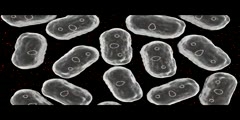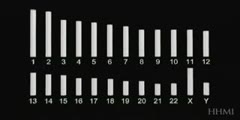The Human Genome Project Video - 3D Animation Introduction
The Human Genome Project (HGP) was an international scientific research project with a primary goal to determine the sequence of chemical base pairs which make up DNA and to identify and map the approximately 20,000-25,000 genes of the human genome from both a physical and functional standpoint. The project began in 1990 initially headed by James D. Watson at the U.S. National Institutes of Health. A working draft of the genome was released in 2000 and a complete one in 2003, with further analysis still being published. A parallel project was conducted outside of government by the Celera Corporation. Most of the government-sponsored sequencing was performed in universities and research centers from the United States, Canada, New Zealand and Britain. The mapping of human genes is an important step in the development of medicines and other aspects of health care. While the objective of the Human Genome Project is to understand the genetic makeup of the human species, the project also has focused on several other nonhuman organisms such as E. coli, the fruit fly, and the laboratory mouse. It remains one of the largest single investigational projects in modern science.[citation needed] The HGP originally aimed to map the nucleotides contained in a haploid reference human genome (more than three billion). Several groups have announced efforts to extend this to diploid human genomes including the International HapMap Project, Applied Biosystems, Perlegen, Illumina, JCVI, Personal Genome Project, and Roche-454. The "genome" of any given individual (except for identical twins and cloned organisms) is unique; mapping "the human genome" involves sequencing multiple variations of each gene. The project did not study the entire DNA found in human cells; some heterochromatic areas (about 8% of the total) remain un-sequenced. Human Genome Project; An introduction to the ongoing Human Genome Project. The dynamic 3D animation will take you "inside" for a close up look at the complexity of the cell. Completed in 2003, the Human Genome Project (HGP) was a 13-year project coordinated by the U.S. Department of Energy and the National Institutes of Health. During the early years of the HGP, the Wellcome Trust (U.K.) became a major partner; additional contributions came from Japan, France, Germany, China, and others. See our history page for more information. Project goals were to identify all the approximately 20,000-25,000 genes in human DNA, determine the sequences of the 3 billion chemical base pairs that make up human DNA, store this information in databases, improve tools for data analysis, transfer related technologies to the private sector, and address the ethical, legal, and social issues (ELSI) that may arise from the project. Though the HGP is finished, analyses of the data will continue for many years. Follow this ongoing research on our Progress page. An important feature of the HGP project was the federal government's long-standing dedication to the transfer of technology to the private sector. By licensing technologies to private companies and awarding grants for innovative research, the project catalyzed the multibillion-dollar U.S. biotechnology industry and fostered the development of new medical applications. Knowledge about the effects of DNA variations among individuals can lead to revolutionary new ways to diagnose, treat, and someday prevent the thousands of disorders that affect us. Besides providing clues to understanding human biology, learning about nonhuman organisms' DNA sequences can lead to an understanding of their natural capabilities that can be applied toward solving challenges in health care, agriculture, energy production, environmental remediation, and carbon sequestration. A genome is all the DNA in an organism, including its genes. Genes carry information for making all the proteins required by all organisms. These proteins determine, among other things, how the organism looks, how well its body metabolizes food or fights infection, and sometimes even how it behaves. DNA is made up of four similar chemicals (called bases and abbreviated A, T, C, and G) that are repeated millions or billions of times throughout a genome. The human genome, for example, has 3 billion pairs of bases. The particular order of As, Ts, Cs, and Gs is extremely important. The order underlies all of life's diversity, even dictating whether an organism is human or another species such as yeast, rice, or fruit fly, all of which have their own genomes and are themselves the focus of genome projects. Because all organisms are related through similarities in DNA sequences, insights gained from nonhuman genomes often lead to new knowledge about human biology.














